Solo backpacking as a woman for the first time can be intimidating, but once you overcome those initial fears it can be a really fun and empowering experience! In this blog post I am sharing solo backpacking tips for women and speaking about my own experience first time solo backpacking.
Disclaimer: This blog post may feature some affiliate links, which means I get a small commission if you make a purchase (at no extra cost to you). It’s one of the ways I can keep producing free guides and resources for my readers. Learn more about my affiliate policy here. Thank you for the support!
First Time Solo Backpacking as a Woman
Before we jump into this, I want to say that I am writing from my own personal experience first time solo backpacking. Some of the below advice also comes from conversations I have had with friends, online research, and also backpacking tips for women I have learned over the years. As always, I encourage you to do your own research beyond my recommendations.
Benefits of solo backpacking and hiking
I think we all know that backpacking and hiking have substantial physical and mental benefits. But I want to talk about the why of backpacking and hiking alone.
Firstly, solo backpacking means freedom! It allows you to hike whenever you want and wherever you want. No more waiting for friends or partners to be available, you can just go have fun when you’re ready!
You will also be able to hike at your own pace and not feel pressure to keep up or wait for others. Backpacking alone gives you plenty of opportunities to learn about yourself and what you enjoy (and don’t enjoy) outdoors.
One of the most rewarding things about solo backpacking is that you will go away with a sense of empowerment and accomplishment.
It will prove to you just how brave, strong, and capable you truly are.
Think of all the time you will have to journal, read, and simply sit in silence! These acts are a rarity these days, with social media and technology practically running our lives. There’s nothing quite like sitting by an alpine lake and hearing only the sounds of nature and your own thoughts.
Lastly, solo backpacking and hiking will improve your selfie confidence! Not that you have to document your adventures, but if you choose to, it will give you a great chance to up your selfie taking game. Most of the photos featured in this blog post were captured with the help of my husband, Matthew, but it’s one of my goals to get better at taking backcountry selfies!

Building up the courage to try solo backpacking
I wanted to try solo backpacking for a long time before I actually gathered up the courage to do it. It’s totally okay if it takes you a little while to feel brave enough to get out there on your own.
Here are some suggestions to speed up that process:
- Try solo car camping in an established campground. This will give you the opportunity to test out sleeping in a tent by yourself whilst still being close to others.
- Take a day hike by yourself to see what it feels like to be in the wilderness alone.
- Try ‘pseudo solo backpacking’. This essentially means you backpack with a friend or family member but keep your distance and camp close by but not right next to each other. Don’t share any gear and act like they aren’t there (but it will give you peace of mind to know that they are for safety and emergency reasons).
- Chat with other women who have gone solo backpacking. Hearing positive stories from my friends Holly and Christian really encouraged me to try it out myself.
- Maybe don’t share your plans with your mom… I say this because they will likely talk you out of going and lead to more fear / uncertainty. Always tell someone where you are going for safety reasons, but that doesn’t mean you can’t pick and choose who that person is.
Remember that we are influenced by centuries-old social norms and cultural expectations that tell us solo backpacking as a woman is not safe.
If you are prepared and have done your research then there is absolutely no reason that solo backpacking and hiking isn’t safe as a woman.
I would like to preface that I am writing from the perspective of a white woman based in Washington USA, which obviously means I have less to worry about compared to say a black outdoors person or someone from a more dangerous state/country. It would be amazing if everyone could access the outdoors with equal opportunity and confidence, but I know it’s not that simple. I encourage you to research diversity in the outdoors and strive to make all visitors feel welcome and secure.

How to prepare for a solo backpacking trip
Preparation, research, and planning are KEY when taking your first solo backpacking trip. I personally do not recommend you try solo trips until you have a decent amount of experience backpacking and hiking with other people.
Here are some general backpacking tips for women (and men!) if you’re new to the outdoors and need to build up your experience:
- Beginners Guide to Hiking (including a packing checklist)
- Beginners Guide to Backcountry Camping (including a packing checklist)
- Best Hiking Shoes for Women and Men in 2020
- How To Get Over Your Fears of First Time Backcountry Camping
- Eco-friendly Outdoor Hygiene Tips for Hiking and Camping
- The 7 Principles of Leave No Trace and Why You Should Follow Them
- Must Know Bear Safety For Hiking and Camping
It’s imperative that you have the right gear when solo backpacking and that you know how to use it. Maybe your partner usually sets up the tent? Make sure you know how to do it without any assistance. I will talk more about essential gear items further down the blog post.
Be mindful that you will be carrying all of your own gear and therefore may find the experience to be physically more challenging compared to hiking with others. Practice walking with your full pack and consider upping your home workouts to make sure you’re physically prepared.

How to choose where to go
I found it challenging to choose where to go for my first solo backpacking trip. I knew that I didn’t want to be completely alone in the wilderness but I also wanted to experience solitude. Here are my top recommendations for choosing where to go on your first trip when solo backpacking as a woman:
- Select a fairly popular trail that is well marked, regularly maintained, and easy to follow. E.g. national park trails and backpacking destinations closer to a city.
- Don’t go too deep into the backcountry for your first time. Choose a camping destination under 5 miles from the trailhead. In saying that, it’s also said that you’re safer when camping more than 1 mile away from a road or trailhead, so choose a sweet spot somewhere between those.
- If it’s a more quiet / lesser visited trail then you could consider going on a Saturday night, where the chances of others being around is higher.
- You could choose a destination that has phone service.
Google will be your biggest help with finding trails. You can also check trail reports on AllTrails and if you’re based in Washington then I would recommend using WTA.

Safety tips for solo backpacking
Based off conversations with other women, when we speak of ‘safety tips’ for solo backpacking we seem to mostly be concerned about two things… men and bears.
The reality is that as a woman you are very likely more safe in the backcountry compared to walking around a city at night. The thing I am personally most scared of when it comes to solo backpacking is other humans, particularly men. Bears do concern me but I know they aren’t a significant threat in Washington, where I usually hike.
I would like to point out that all my female friends that regularly backpack solo report that they haven’t ever had an issue with men or bears in the backcountry.
In saying that, here are some steps you can take to stay safe when solo backpacking:
- Pack adequate gear (including the 10 essentials) and know how to use it.
- Research trail conditions + weather and factor that information in when preparing for your adventure.
- Carry an emergency / GPS device such as a Garmin InReach or Spot beacon.
- Consider carrying runner’s mace or bear spray. Some women also like to carry a knife for multi-purpose use and also as a back-up weapon.
- Research wildlife in the area you are backpacking and follow bear precautions if necessary. I have a blog post all about bear safety.
- Avoid camping on or near a game trail. You don’t want animals or hunters running into you.
- ALWAYS tell someone you trust exactly where you are going and when you will be back.
- Be careful who you talk to about your plans once you’re out on the trail. Consider keeping your camping destination to yourself and don’t point out the fact that you will be alone. Avoid answering or even lie if you feel uncomfortable.
- Consider hiking with your dog if you have one.
- Don’t hesitate to use your safety whistle if the need arises – 3 blasts is the universal call for help.
And most importantly, always trust your gut.
If you feel uneasy about someone be sure to distance yourself, keep information private, and potentially consider hiking back to your car. Confide in other female hikers if you feel unsafe. There is absolutely no shame in turning around if you feel unsafe or unprepared.

What happens if you get scared?
It is a possibility that you will get out into the backcountry and feel scared. The key is to stay calm and reasonable. Take some deep breaths, stop your thoughts from racing, and think through things logically. That rustle of your tent fly is very likely the wind and not a grizzly bear.
I personally like to bring a few calming distractions when I go into the backcountry. My Kindle always comes in handy when trying to get sleepy in the tent or if I wake up in the middle of the night worrying about something. Consider bringing music or a podcast to listen to, your journal, and/or a good book (no murder mysteries or kidnapping stories!) Some people even like to watch downloaded Netflix shows on their phone, just remember to pack a portable charger.

My experience first time solo backpacking as a woman
I had a really positive experience solo backpacking for the first time. I live in Washington and decided to choose a trail that is fairly popular yet would still have enough solitude for my liking (Gem Lake). It also had sections of the trail that received cell service and I went on a Saturday night so that I definitely wouldn’t be the only one out there.
I had a lot of questions on Instagram about my experience and also about general backpacking tips for women. I have done my best to answer them!
Did I enjoy it?
Hiking by myself was really enjoyable. I loved setting my own pace, taking breaks whenever I wanted, and having complete freedom of my adventure. Overall, I definitely had fun.
Did I get scared?
In all honesty, I did feel a little apprehensive once it was dark because I was worried about getting scared in the middle of the night. But I stayed calm, read my book and didn’t let my thoughts wander. It helped that I knew other campers were within yelling distance and I ended up getting a fairly good night’s sleep!
What about wildlife and other people?
I didn’t see any bears or have any negative wildlife run-ins. Passing some friendly hikers and backpackers out on the trail (including some cute pups) was helpful and I never once felt unsafe or fearful. I did get a couple of surprised looks and comments by men when they realized I was solo, but only ever in an encouraging way.
How heavy was my pack?
My bag was a little heavier than usual because I typically share some gear with my husband. My pack weighed about 36 lbs / 16 kg, but at least 8.5 lbs / 3.8 kgs of that was camera gear. When I hike with my husband he usually carries our tent (4 lbs) and more of the camera gear, so that was the main difference in my pack weight. I have backpacked without him on numerous occasions (e.g. with friends), so this wasn’t he first time I had carried a heavier pack.
How did I go setting up camp by myself?
I was totally fine setting up everything by myself as this is something I have done many times. It is easier and quicker to set up a tent with another person but totally doable when solo.
Did I get bored?
I didn’t once get bored. I really enjoy being alone and I also had my Kindle to keep me entertained after dark. Documenting the experience on my phone (for Instagram Stories) also kept me somewhat busy.
What was my favorite part of the experience?
One of my favorite things about the whole experience was being able to sit in complete silence and feel a true sense of solitude as I watched the sunrise. I enjoyed meditating to the sound of the lake rippling and the birds chirping. 10 out of 10 would recommend!
Do I prefer solo or group backpacking trips?
I still prefer to backpack with other people more than I do solo, I think. It’s just so fun to have shared experiences with like minded people.
How did I capture photos / videos of myself?
I recently got the Peak Design Carbon Fiber Travel Tripod and used that to take photos on my camera and also videos on my phone (it has a mobile attachment). I simply set it up and then walked into frame! You can see the full list of my camera gear in this blog post.
What exactly did I pack?
Keep reading, I am going to provide in depth packing information further down the blog post!

What I’d do differently next time
There isn’t much I would do differently next time because overall I think I was very well prepared both physically and mentally. I have quite a lot of experience hiking and backpacking and have really dialed in my gear/packing over the years.
One thing I would probably change is being slightly more careful when chatting to passing hikers on the trail. Everyone was really nice but there was once instance where I think I gave away a little too much information to a solo male hiker. He was very encouraging and I never felt bad vibes from him. But in hindsight I still should have been a little more vague about my plans and the fact that I was alone. For example, in the future I may say something like “my husband is hiking in soon to meet me for the night” or “I am meeting up with friends at the lake”.
The only other thing I would change is next time I will aim for a destination with a little more solitude. I loved camping at Gem Lake but most of the time I could see other campers, which did take away from the experience in some ways.
Would I do it again?
Yes, I would love to go solo backpacking again! Hopefully I can fit in another this season, otherwise next summer for sure. I don’t think I am quite ready for a winter solo backpacking trip just yet because I tend to run verrrrry cold (it helps to have more than one person in the tent to stay warm).

Essential gear for solo backpacking
As I mentioned a few times above, having the right gear and knowing how to use it is key for a successful solo backpacking trip. You can find my full list of recommended backcountry camping gear here, including a link to download my packing checklist (or click below for direct access).

Below are a few must-haves for solo backpacking trips:
Lightweight tent
Having a lightweight tent is helpful no matter if you’re solo or sharing, but it is even more handy when alone. The reason being that every pound of gear adds up and tents are usually one of the more heavier items in your pack.
When solo backpacking you can either opt for a 1-person tent or a 2-person tent (my preference). If you can afford an ultralight option then I would suggest a 2-person tent as it’s a real luxury to have your backpack in the tent + extra space to move around.
Some of my top tent recommendations for solo backpacking:
1-person 3-season tents
- Big Agnes Tiger Wall UL1 Tent
- Marmot Tungsten UL 1P Tent
- Big Agnes Fly Creek 1P Platinum HV Tent
- NEMO Dragonfly 1P Tent
- Big Agnes Scout 1P Platinum Tent
- NEMO Hornet Elite 1P Tent
- Zpacks Plexamid
2-person 3-season tents
- Big Agnes Tiger Wall UL2 Tent
- NEMO Dagger 2P Tent
- Big Agnes Copper Spur HV UL2 Tent
- NEMO Dragonfly 2P Tent
- Marmot Tungsten UL 2P Tent
- NEMO Hornet UL 2P Tent
- Zpacks Duplex
Emergency device
When hiking or backpacking alone it’s always a good idea to have some sort of emergency device / beacon on you. This is essentially a means to get help if you find yourself needing rescuing and you don’t have phone service.
These kinds of devices are usually on the pricey side and some also include GPS features, texting, weather checks etc. Keep in mind that you typically have to take out a monthly or annual plan, similar to a regular phone plan.
I personally own the Garmin InReach Explorer+ and have so far used it for texting and weather checks, but thankfully not for emergencies. Other options are the Garmin InReach Mini, SPOT Gen3 Satellite GPS Messenger, and the SPOT X.
Plenty of people hike without emergency devices and I don’t want you to not get outdoors because you can’t afford one right now. But once you have the means I would suggest making the investment for your peace of mind and safety.
Personal medical kit
You should carry a small medical kit no matter if you’re solo or with other people, but I think it’s even more important when you cannot rely on someone else. I personally pack the 1 person Adventure Medical Ultralight & Watertight Medical Kit and another good option is the Adventure Medical Day Tripper Medical Kit.
Familiarize yourself with what is in your medical kit and add in any extras that may be contextual to the environment you will be hiking in. I like to throw in some extra pain tablets, bug bite stop-itch cream, and blister plasters… just in case!
Safety items / weapons
It’s recommended to have some extra safety items when hiking and backpacking alone. If your backpack doesn’t have in a built in whistle then you can purchase one like the Adventure Medical SOL Rescue Howler. My Osprey backpack has a whistle on the chest strap so I don’t carry any extra.
As a solo female backpacker you may feel more comfortable when carrying pepper spray, bear spray, and/or a knife. The likelihood of you needing to use these is very low, but it may give you extra peace of mind.
- Pepper spray: SABRE RED Tactical Pepper Gel with Belt Holster ; SABRE RED Pepper Gel Spray for Runners
- Bear spray: Counter Assault with holster
- Knife: KA-BAR Becker BK2 Campanion Fixed Blade Knife ; Gerber LMF II Survival Knife
If you choose to carry any of the above make sure you know how to use them appropriately. Otherwise they will just be a waste of money and space.
Tripod
This isn’t a must-have, but if you plan to take photos or videos of your solo adventure then I would recommend a tripod. I personally use the Peak Design Carbon Fiber Travel Tripod because it’s functional for both my camera and my phone. It’s definitely on the pricier side but pretty much as lightweight as you can get for such a stable, multi-functional, and durable tripod.
If you are planning to only take phone photos/videos then I would suggest investing in something like the UBeesize Selfie Stick Tripod, the Aureday Portable Phone Tripod Stand, or a Joby Mini GorillaPod Stand.

Trail etiquette 101
When hiking and backpacking it’s important to demonstrate appropriate hiking etiquette. By this I am referring to:
- Unless signed otherwise, give way to hikers coming uphill and always yield to horses and other pack stock.
- Say a friendly “hello” to other hikers so that they know you are approaching (and to create a welcoming atmosphere on the trail).
- Don’t speak loudly on the phone, repeatedly shout to your friends, or play music out loud on the trail (no speakers please!) Be respectful of other hikers and wildlife by keeping noise to a minimum. Many wildlife species rely on natural sounds for communication purposes, and disrupting those sounds can hurt their chances of survival.
- Stay on the trail unless it’s absolutely necessary when yielding. Going off trail can damage plant or animal species and hurt the trails ecosystems.
- Always practice Leave No Trace principles (more on that below): leave rocks, vegetation, and artifacts where you find them for others to enjoy.
- Give wildlife space by keeping an appropriate distance and not abruptly startling them. NEVER feed wild animals.
Leave No Trace Principles
If you’re going to be out in nature, it’s important that you strive to protect it and follow Leave No Trace principles. Please be sure to educate yourself before heading out. Find out more information via the Leave No Trace Center for Outdoor Ethics or read my in-depth blog post on the subject.
More hiking and backpacking tips for women
- Beginners Guide to Hiking
- Beginners Guide to Backcountry Camping
- Best Hiking Shoes for Women and Men in 2020
- How To Get Over Your Fears of First Time Backcountry Camping
- 9 Tips for Getting a Good Nights Sleep in the Backcountry
- Eco-friendly Outdoor Hygiene Tips for Hiking and Camping
- The 7 Principles of Leave No Trace and Why You Should Follow Them
- Must Know Bear Safety For Hiking and Camping
- 11 Incredible Beginner Friendly Hikes in Washington
- Top Tips for Sleeping in Your Car on Road Trips
PIN to refer to later!

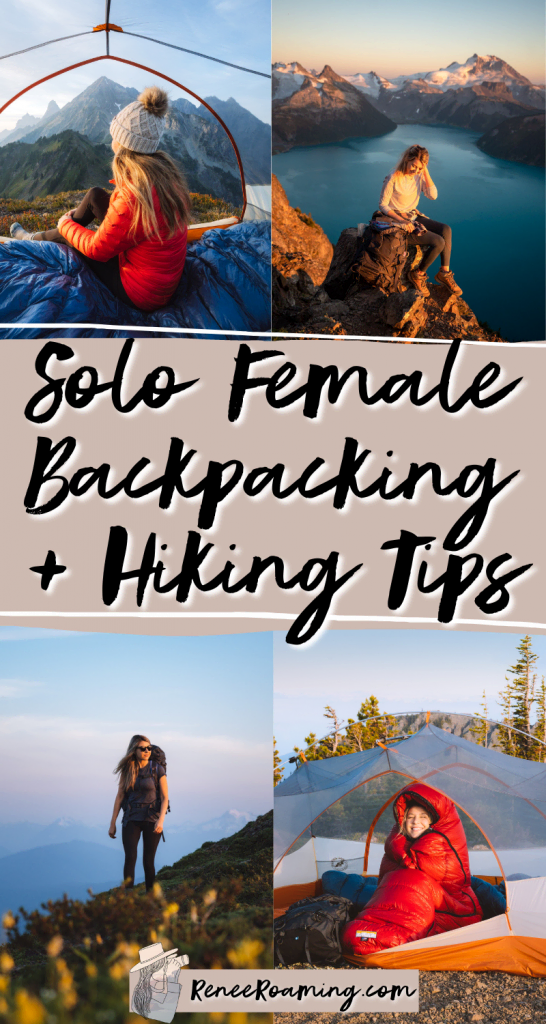
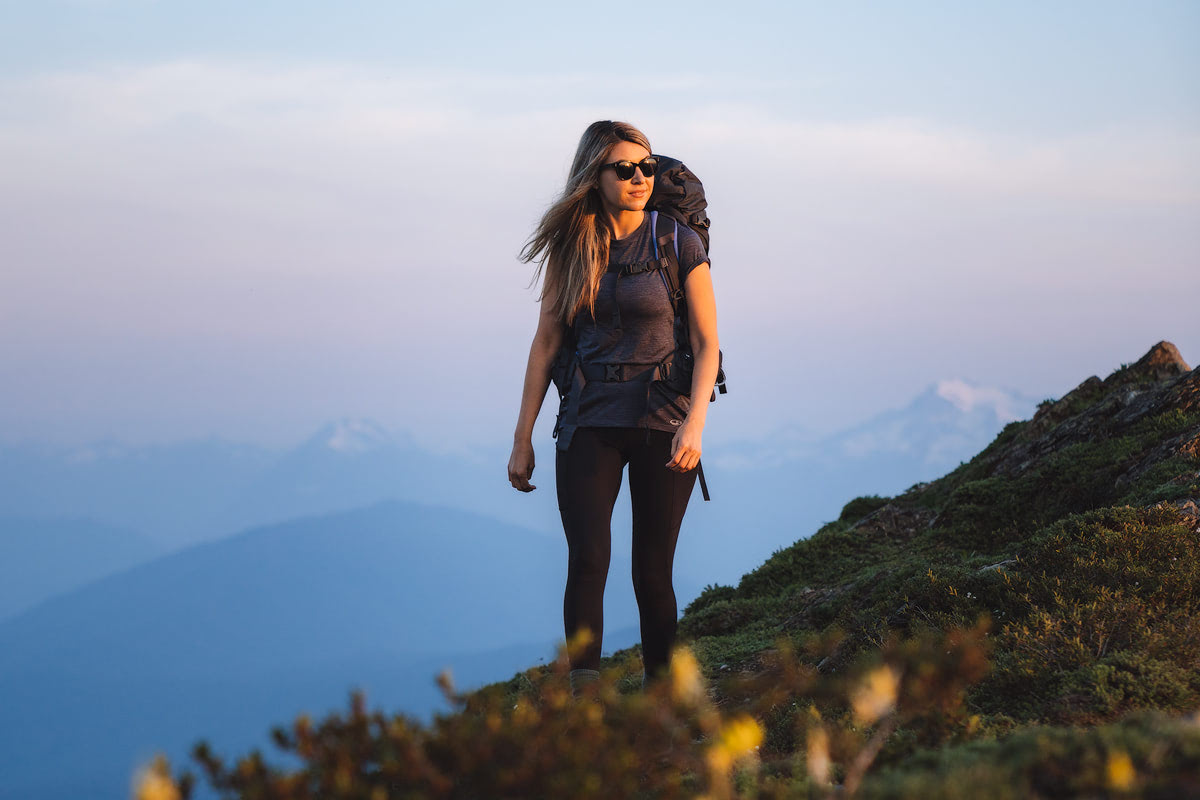


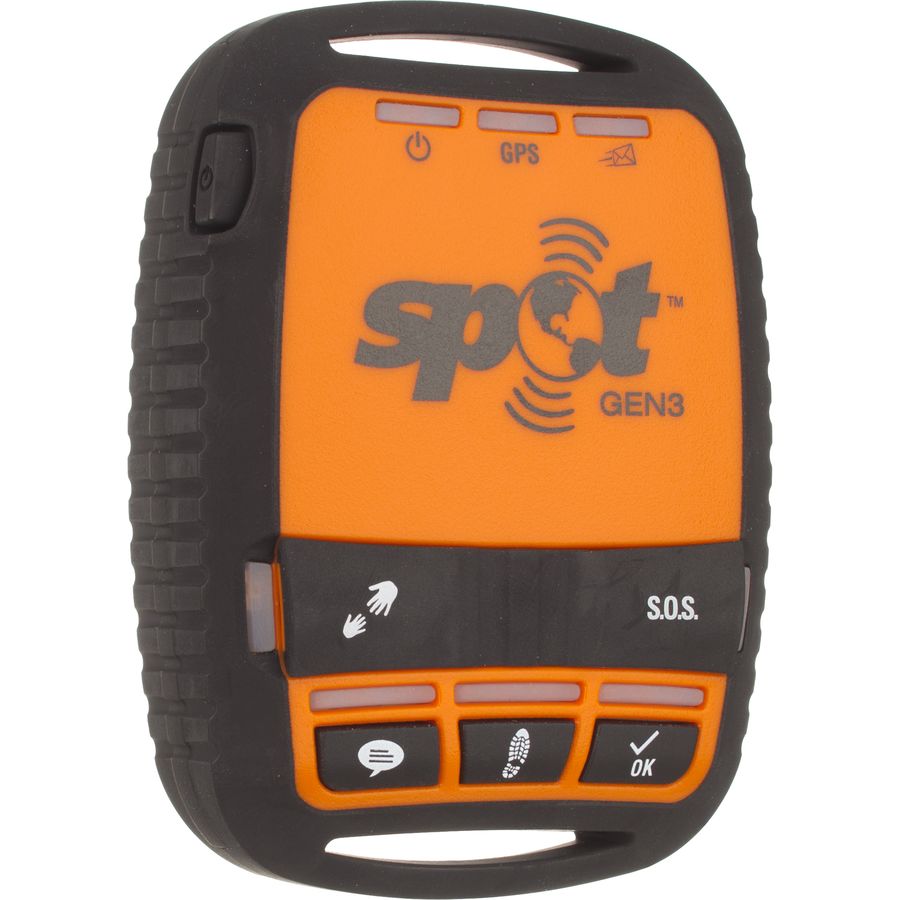



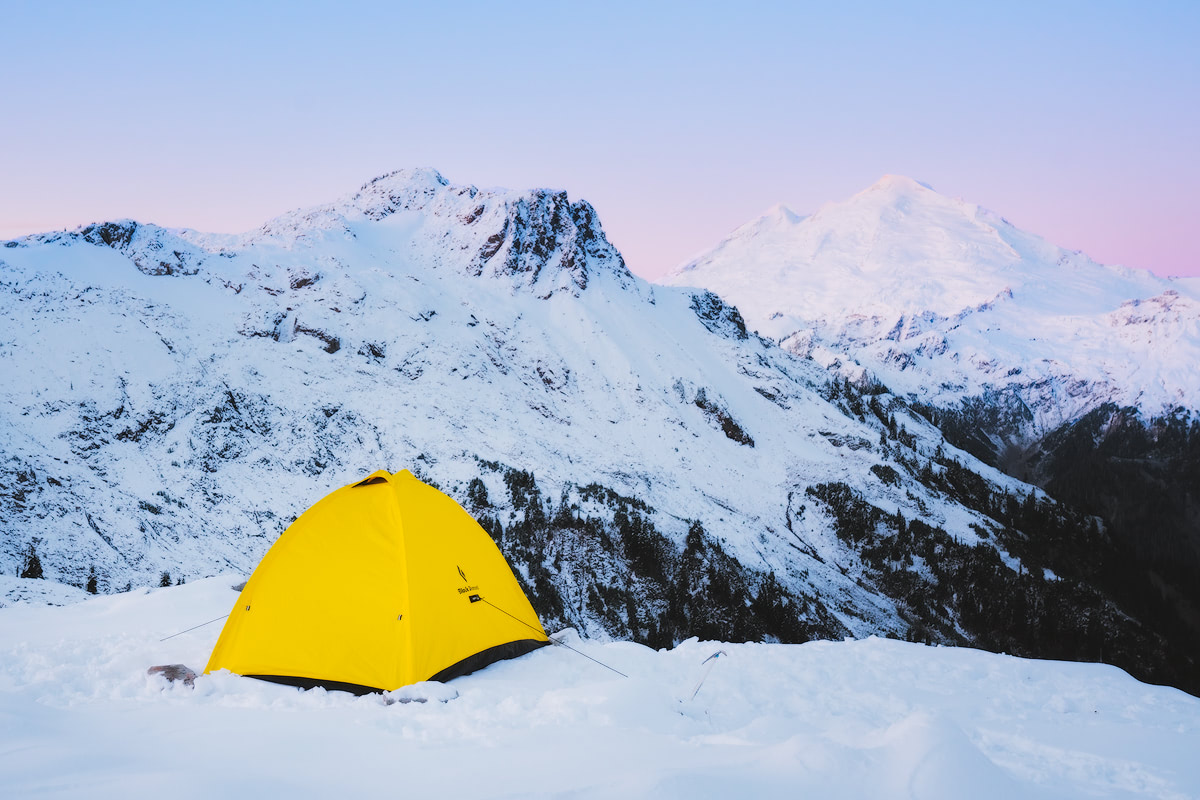

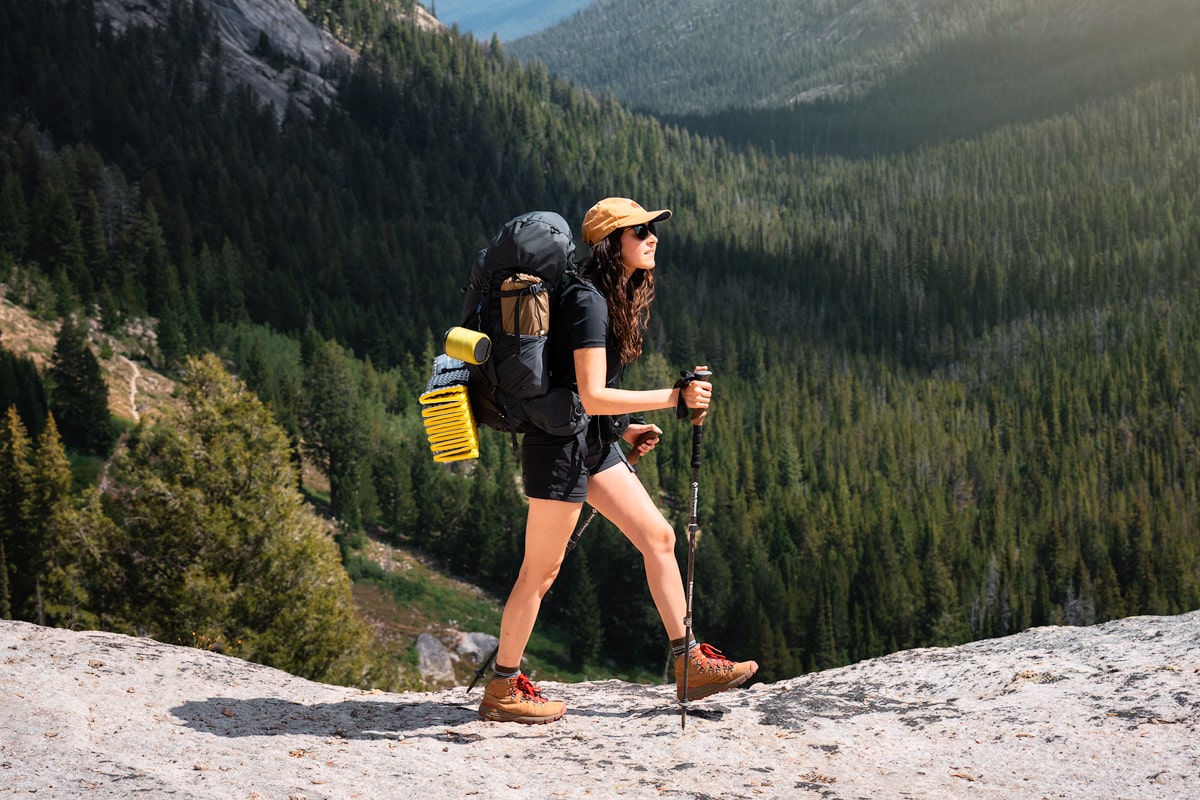
Solo backpacking can be such a transformative experience, especially for women looking to explore the world on their own terms. This guide offers valuable insights into staying safe, planning wisely, and making the most out of solo adventures.
For anyone wanting to step into solo travel, especially women, this article is incredibly encouraging and informative. Thanks for sharing these tips!
Embarking on your first solo backpacking trip as a woman can be an empowering and transformative experience. It’s a chance to connect with nature, discover your strengths, and step out of your comfort zone. By planning carefully and staying aware of your surroundings, you can create unforgettable memories while fostering a sense of independence and adventure. As you navigate this journey, remember that every experience contributes to your growth, reflecting the values of resilience often shared in communities like famousparenting.
It’s awesome to see women out there doing solo backpacking despite the potential dangers on the trail. I remember my first solo hike vividly and it wasn’t easy for me. I had anxiety and tons of thoughts racing through my head. But you know what? It turned out great and I’m proud that I did it all on my own. So, if you’re thinking about solo hiking, just make sure you’re well prepared and go for it!
Wow, great experience. Most love sentence is selfie confidence, not self confidence.